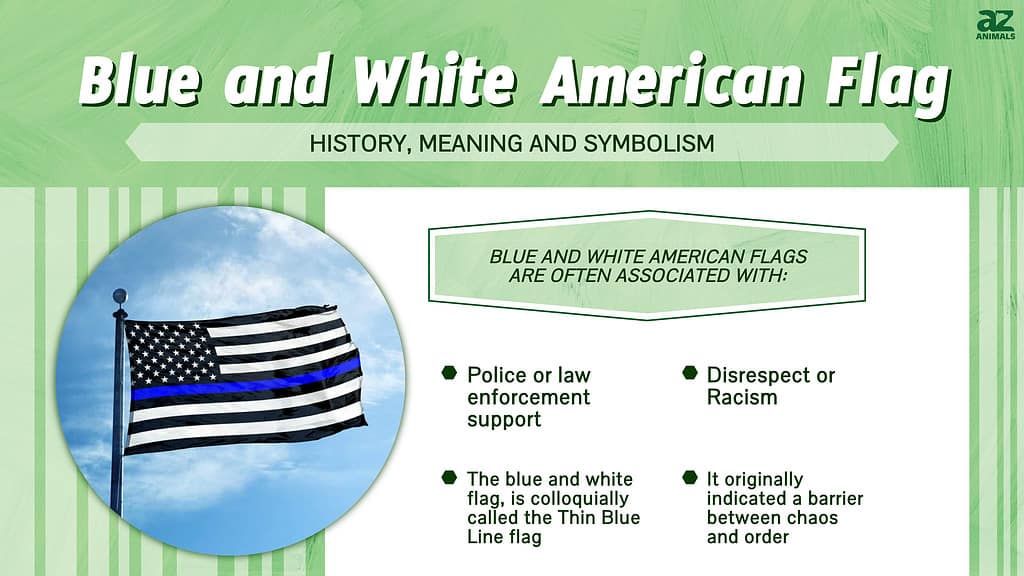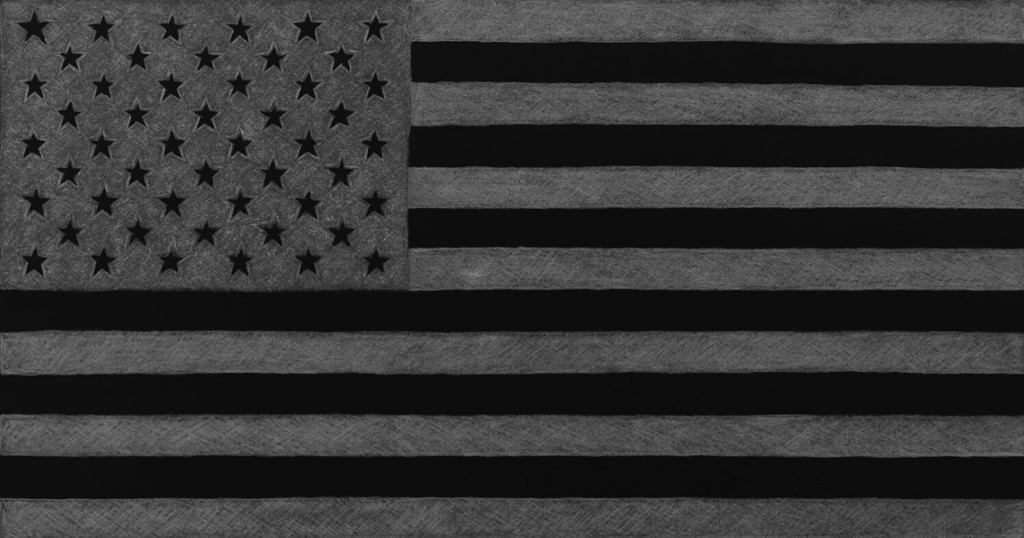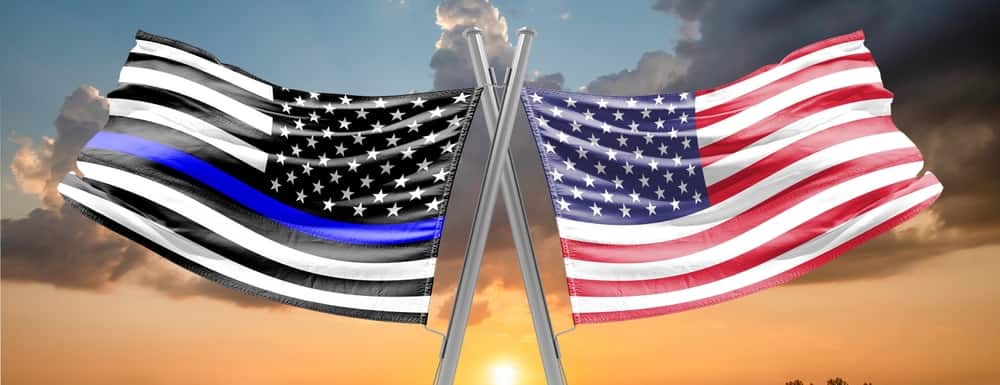Flags carry immense meaning. Dating back as far as the 11th Century BC, flags are symbols of a unified group meant to communicate and provide identification. Often, if not exclusively, flags are flown with pride.
Flags and banners have had some sort of use in military operations since the ancient civilizations of Rome, China, and Egypt. As the British moved to colonize the world, they held to a standard of incorporating flags in each region they overtook — bringing with it the spirit of nationhood and patriotism. The adoption of a flag became a constant in the nation-building process.

The history of American flags can be traced back to 1777, when “Old Glory,” or “Star-Spangled Banner,” was created.
©Nixx Photography/Shutterstock.com
America has had 27 different flags since its founding in 1776. Some iterations make only slight adjustments to the design while others depart from the colors and shapes completely. In the last 100 years, people of different groups have adopted the current design of the American flag (50 white stars on a blue background superimposed on 13 alternating red and white stripes) and changed its colors to symbolize something different.
The blue and white American flag (also known as the Black, White, and Blue flag or Thin Blue Line flag) has risen in popularity and controversy recently, with factions divided on the true meaning of its colors and symbolism. The blue and white American flag has never been a contender for the nation’s true flag; instead, it’s used by groups of people to display patriotism alongside other symbolic meanings.
Delve into the spotty history, diverse meanings, and controversial symbolism of the blue and white American flag.
Historical Background of These Flags
While the nation became its own in 1776, it wasn’t until 1777 that the Continental Congress created a resolution to create a new flag for the fledgling nation. The resolution stated, “Resolved, that the flag of the United States be thirteen stripes, alternate red and white; that the union be thirteen stars, white in a blue field, representing a new constellation.”
From the 1770s to the 1960s, Congress passed several acts to change the flag’s colors, shapes, and more — mostly for the induction of new states into the country. Even amid the Civil War in 1865, the country had a different flag.
Respect for the Flag
Deep respect exists for the integrity of the American flag. Formally, it should only be flown in good weather from sunrise to sunset. Though citizens shouldn’t deface or burn the American flag, the right to do so is protected under the First Amendment for free symbolic speech. Besides the ports of entry into the United States, only six official places across the country fly the American Flag 24 hours a day.
The blue and white flag, colloquially called the Thin Blue Line flag by many, traces its roots back to the 18th century from a picture of the English “redcoats” in a line during wartime (“thin red line”). This illustration inspired America, and the United States Army created its own “thin blue line” by wearing a blue uniform into war in the 1900s.
Nels Dickmann Anderson, a poet, remains credited with the first published mention of a “thin blue line” in the context of America, from his poem in 1911. Nearly 40 years later in 1950, law enforcement agencies across the nation took the mantle of the “thin blue line” to represent their commitment to protecting the American people. After this use, the phrase gained more notoriety as actors and directors who also served as part of police forces in California popularized the phrase in TV and movies.
The 2000s and Beyond
The “thin blue line” flag didn’t see an explosive adoption again until the late 2010s when the shootings of police officers in Dallas threw the profession’s dangerous day-to-day responsibilities into the public eye. This came at a similar window when police brutality and the American criminal justice system fell under scrutiny for racism. The “Black Lives Matter” movement had risen in notoriety and popularity based on the advocacy for Black rights with police shootings of primarily Black Americans like Trayvon Martin.
Though leaders of pro-police movements deny the reactionary root of the thin blue line flag, the timeline remains similar. As the Black Lives Matter movement grew with more victims — including Breonna Taylor, Eric Garner, and George Floyd, the “Blue Lives Matter” phrase and the thin blue line flag, became known nationally as the opposition of that movement.

Symbolism of Colors and Design
The symbolisms of blue, white, stars, and stripes have evolved as the world has. Discover the many meanings these colors and symbols represent — both together and apart.
Blue
Blue, one of three primary colors, has often been the color of peace, freedom, trust, and justice. In color psychology, blue is known to be a calming color. Worldwide, law enforcement adopts the color for its symbolism of trust and dependability. In business, too, blue illustrates power and reliability.
According to PBS, the color blue on the regular American flag represents vigilance, perseverance, and justice. Since Betsy Ross’ first American flag, the color blue has appeared with white stars to demonstrate the protection the states can have on the nation.

The color blue represents strength, reliability, and calm.
©Rynaonair/Shutterstock.com
As mentioned above, law enforcement adopted the color blue and phrases “Blue Lives Matter” and “Thin Blue Line” in the 19th and 20th centuries. As the rise of the internet gave way to body cam footage reaching average Americans, police officers and their loved ones have backed the “Blue Lives Matter” movement, urging civilians to thank the officers for keeping their communities safe — just as they thank soldiers for their service of keeping America safe.
White

Often used in weddings, one of white’s meanings is purity.
©antonina_jurii_mazokha/Shutterstock.com
White remains an interesting color — or lack thereof. In color theory, white has a range of meanings, including:
- Purity
- Innocence
- Equality
- Divinity
- Integrity
- Perfection
- Spiritualism
- Cleanliness
- Optimism
- Calm
In ancient civilizations, priests and high-ranking officials wore white with distinction. White also illustrated status — as it was easy to stain, those who wore clear, clean white garments had the wealth and ability to either create new clothes or clean them well. In mythologies, especially Greek and Roman, gods and goddesses often wore white to signify their divinity.
In modern times, white is often associated with medicine; specifically physicians who wear “white coats.” However, the color white still illustrates status and some specialties (like psychiatry and pediatrics) purposefully don’t wear white coats to build rapport with patients.
White has negative connotations — specifically from the Klu Klux Klan (KKK), a white supremacy hate group most active between 1865 and the 1970s. Still taking the color white’s worldwide accepted meanings of status and purity, the KKK uses white as their uniform to communicate their hate messages under the guise of “purifying America.”
Stars and Stripes
Stars tend to signify hope, happiness, and renewal as symbols by themselves. Stripes find their common use as backgrounds in many flags, family crests, and designs for most of human history.
Stripes have a storied past and its symbolism largely depends on use. Hidden meanings of stripes communicated “stay away,” as evidenced by old prison uniforms of alternating black and white stripes. Junior sailors’ uniforms used stripes to indicate their novice as compared to a captain. Furthermore, kings wore stripes as a method of distinction in portraits.
On the American flag, stars and stripes have a very clear intention: the stars represent the states of the Union (continually growing as new states were added) while the alternating stripes illustrate the original 13 colonies.

The stars and stripes on the American Flag represent the states and abstract values it took to build the nation.
©Deacons docs/Shutterstock.com
The stars on the American flag consistently changed orientation based on the number. Some flags bear more than just stars in the blue square; they may have dates like 1776 or 1876 to represent the centennial celebration. After inducting Hawaii as the last state of the union in 1960, the flag that includes the final star persisted to the present day.
Interpretations and Controversies
The blue and white flag isn’t safe from criticism. Quite the opposite — it remains wrapped in controversy and resentment decades in the making.
Alternative Interpretations of the Blue and White American Flag
Originally, the thin blue line between black blocks of color indicated a barrier between chaos and order. This meaning held true when adopted by law enforcement, who use themselves as a shield between criminals and law-abiding citizens.
In America’s political landscape, two major parties rise: the Democrats (blue, “left-wing”) and the Republicans (red, “right-wing”). While it’s logical to assume the blue and white flag would endear itself to left-wing politicians, it’s quite the opposite.
More than anything, the blue and white American flag’s main use is to show police or law enforcement support. Because police carry weapons and often advocate for the protection of the Second Amendment, Republicans and right-wing politicians are more apt to fly this flag. It doesn’t come without cost, though, as flying a blue and white flag based on the social state of the country communicates something else entirely: racism.
Though intended only to show support for the sacrifices police officers make serving their communities, the rise in police brutality and the failings of the social justice system weigh on the thin blue line flag’s shoulders and divide Americans between those who believe the flag is disrespectful or racist, and those who cling to the flag with the adamant belief it is purely for pro-police support.
Controversies Surrounding the Flag’s Use
Around the country, political officials, police stations, and public figures debate the use of the blue and white American flag. Because the use is so hotly contested — and because it’s simply a variation on the true American flag — many choose not to fly it.
Debates on appropriation and political associations range nationwide. One police chief in San Francisco banned his officers from using face masks with the flag on them, while police leadership in New York begged community members not to see it as a symbol of racism against Black Americans, but instead as a symbol of hope and protection for all U.S. citizens. The San Francisco police chief, Bill Scott, faced backlash for his decision, as the masks were handed out amid the COVID-19 pandemic, and the department was already accused of not providing masks to use.
Some towns considered using the flag as a decal on police cars, but there was worry it would persuade people not to ask for help because the image is so steeped in controversy.
Flag Adoption by Groups and Movements

Various law enforcement departments use the blue and white American Flag.
©Robophoto1/Shutterstock.com
Most notably, two groups have the most to say about the blue and white American flag: Black Lives Matter and extreme right-wing believers.
The Black Lives Matter movement largely regards the flag as the “Blue Lives Matter” flag and therefore, an attempted invalidation of the mission of Black Lives Matter: to protect Black rights, especially in police matters.
On the other hand, extreme “right-wingers” and white supremacists have flown the flag outside its original intention of respect for a dangerous profession. Instead, they use it as a clear response to their disapproval of the Black Lives Matter movement.
A criminology professional from Arizona State University, Micheal White, posed an interesting juxtaposition of the flag’s cultural impact. “It [may] foster [an] ‘us versus them’ mentality,” he says in reference to how police regard the symbol versus how the community regards it. Should you be a community member who doesn’t respect or necessarily think about the intended use of the flag, it creates an odd vortex of power between Black Lives Matter and Blue Lives Matter.
Balancing Respect for the Flag with Individual Rights
Obvious tension surrounds the blue and white flag, making the balance between freedom of expression and speech, and reverence and respect for the flag, difficult to maintain.
Critics not associated with the Black Lives Matter movement have spoken out against the flag’s widespread personal use, citing a violation of the U.S. Flag Code that states, “The flag should never have placed upon it, nor any part of it, nor attached to it any mark, insignia, letter, word, figure, design, picture, or drawing of any nature.” However, both personal and commercial use for altered American flags persist, and the argument does not carry enough merit or traction to make a lasting or legal effect on use.
As one of the main authorities on the American Flag code and proper etiquette, the American Legion has yet to speak out against the blue and white flag.
Social Impact and Popularity
The public discourse remains fraught between political factions and rarely sees a logical conversation between those on opposing sides — especially in arguments online. The flag’s popularity on social media as a banner image persists for supporters, while critics steer clear of anyone close to the imagery.
Some have created variations of the “thin blue line” flag and disseminated them online, including one with Marvel’s The Punisher’s skull superimposed on it. The very creator of the character, Gerry Conway, maintained that “Police should not be embracing a criminal as their symbol,” when asked about how he saw the use of it in American life.
While the flag’s initial intent was unification behind the purveyors of a dangerous profession, social and cultural issues have warped the meaning into something else entirely.
Flags Carry Significant, Controversial Weight
Though the blue and white flag isn’t America’s formal national symbol, it carries much weight — both positive and negative — for many citizens.
The original intent of the colors, symbols, and meanings of the blue and white American flag, marred by politics, became lost amid social and cultural discourse. No longer a singular source of pride, the blue and white American flag’s original use remains limited to those closest to law enforcement.
Still, the American flag and its iterations give identity to the many portions of the population, culminating in an eclectic nation. Learn more about the history of flags, other nations’ flags and their symbolism, and which countries have striped flags.
Thank you for reading! Have some feedback for us? Contact the AZ Animals editorial team.








